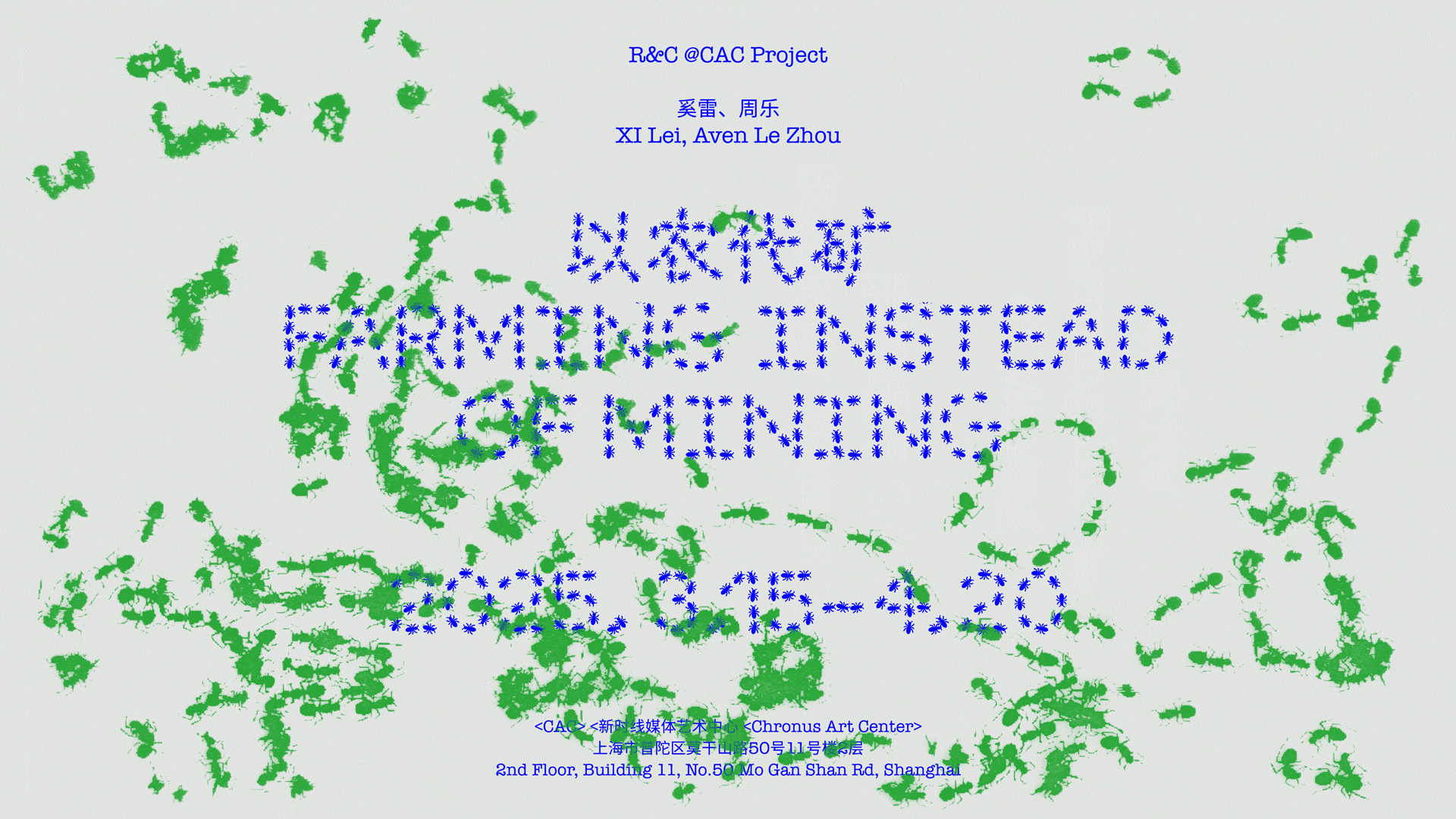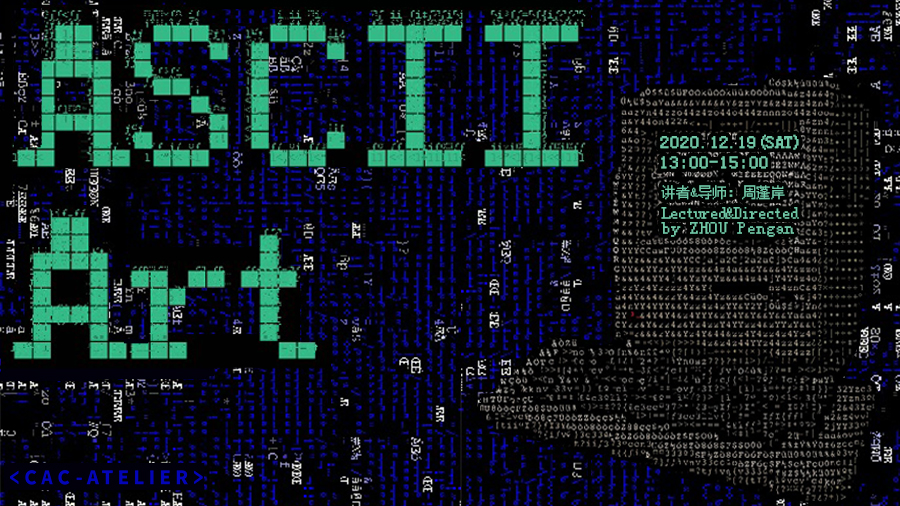Research/Creation Fellowship Program
Chronus Art Center
Shanghai, 2015
Chronus Art Center is pleased to announce that the inaugural Research/Creation Fellowship (USD$30,000) has been awarded to Daniel Franke for his project proposal “Abstract History Machine.” The selection was made from a competitive pool of international applications. The jury consisted of CAC advisory board members Ken Goldberg, George Legrady, Christopher Salter and Fito Segrera, CAC’s head of Research and Creation.
Jury Statement:
Chronus Art Center's (CAC) fellowship program is conceived to support and advance research based artistic practice, in particular, assisting artists who employ scientific methodologies in experiments leading to the conception and production of artworks. The selection was based on the strength of the proposed project and evidence of the candidate’s past accomplishments that demonstrate the potential to advance technical and artistic investigation in relation to CAC's research/creation lines of inquiry.
The proposal suggests a technological artifact that smoothly oscillates between a history archive and a dynamic sculpture; a process that will solidify into a media device both as a functional tool for academic exploration and as an aesthetic object. Based on the Deleuzian idea of an Abstract Machine, Franke introduces the vector of time and history, as one element, into the creative process. The artist's proposal combines the acts of observation and analysis of both scientific and social spheres, more precisely, “Abstract History Machine” proposes a way of conceiving geological variations over time as means of studying and experiencing cultural development and the history of Chinese media artifacts in unconventional ways.
About the Work:
Abstract History Machine / Daniel Franke
How can we perceive history? Starting from this question, the work explores important historical Chinese developments in technology, science and culture by creating a “time-sculpture”, which works with the idea of a dynamic archive. By doing so, it also scrutinizes human time-perception and history and takes as an approach to transfer history's artificial timeframes into a scale, perceivable by humans.
A textual starting point for the work consists of two dimensions: first an archeological analysis of Chinese media artifacts, following Siegfried Zielinski's notion of “deep time” and second, a geological aspect arguing with Jussi Parikka.
“Abstract History Machine” will explore the mineral sedimentaries of China, that, importantly to say, were in a constant correspondence and exchange with the West, thus making it difficult to say what direction drove a certain innovation: which moves the artifact to the center of a diffuse cloud of possible outcomes that reach also into the present.
Artist's Bio:
Daniel Franke (b. 06.09.1982) is an artist, researcher and director living and working in Berlin. He studied Visual Communication and Media Art at the Berlin University of the Arts and completed his master thesis studying under Joachim Sauter and Alberto DeCampo in 2011.
He is also one of the founders of LEAP (Lab for Emerging Arts and Performance), a Berlin-based non-profit interdisciplinary space for emerging, digital media arts and performance that aims to initiate the dialogue between art, science and technology. LEAP’s central concept is based on experimental research in digital technologies and media, which shape and change our present and future society and stimulate new discourses, discussions and questions.
In his own work he challenges our understanding of the digital, aiming to view it in the context of a physical perception in the field of animation. He thereby transforms practises known from classical animation into tangible expressions in the “real”, factual and bodily world to explore and visualise complex coherences. Complexity theory is also a core element in his PhD thesis with the title "Art in the Age of Irrational Computing: Emotion as Emergent Property at the Interface of Art, Technology and Science".
About the Jury:
Ken Goldberg
Ken Goldberg is an artist, roboticist and UC Berkeley Professor with appointments in Industrial Engineering and Operations Research (IEOR), Electrical Engineering/Computer Science (EECS), Art Practice, the School of Information, and in the Department of Radiation Oncology at the UCSF Medical School. With his students and colleagues, Ken has published over 200 peer-reviewed technical papers on algorithms for robotics, automation, and social information filtering. Ken is Founding Director of UC Berkeley's Art, Technology, and Culture Lecture Series and Faculty Director of the CITRIS Data and Democracy Initiative. Goldberg's art installations are related to his research and have been exhibited at venues such as the Whitney Biennial, Berkeley Art Museum, SF Contemporary Jewish Museum, Pompidou Center, Buenos Aires Biennial, and the ICC in Tokyo. Goldberg co-wrote three award-winning Sundance documentary films, "The Tribe", "Yelp", and "Connected: An Autoblogography of Love, Death, and Technology" and co-directed the Emmy-Nominated Short Doc "Why We Love Robots." Goldberg is represented by the Catharine Clark Gallery in San Francisco. His Erdos-Bacon number is 6.
George Legrady
George Legrady is Chair of the arts-engineering Media Arts & Technology PhD program at the University of California, Santa Barbara, director of the Experimental Visualization Lab, and professor of digital media in the College of Engineering and the College of Humanities and Fine Arts. He is an internationally published scholar and exhibiting media artist, a pioneer in the field of interactive digital media arts. His contribution to the field since the early 1990’s has been in creating digital media interactive installations based on a set of conceptual positions for intersecting cultural content with data processing. His current research engages with data visualization, robotic computational integrated photography, and digital visual ethnography. His computational based installations have been exhibited internationally in multiple venues from fine arts museums and galleries, alternative spaces, academic conferences, and public commissions. He has received awards from Creative Capital Foundation; the Daniel Langlois Foundation for the Arts, Science and Technology; the Canada Council; the National Endowment for the Arts, and the National Science Foundation.
Christopher Salter
Chris Salter is an artist, University Research Chair in New Media, Technology and the Senses at Concordia University and Co-Director of the Hexagram network for Research-Creation in Media Arts, Design, Technology and Digital Culture, in Montreal. He studied philosophy and economics at Emory University and completed a PhD in directing and dramatic criticism at Stanford University where he also researched and studied at CCMRA. He collaborated with Peter Sellars and William Forsythe and the Frankfurt Ballet. His artistic work has been seen all over the world at such venues as the Venice Architecture Biennale, Vitra Design Museum, HAU-Berlin, BIAN 2014 (Montreal), LABoral, Lille 3000, CTM Berlin, National Art Museum of China, Ars Electronica, Villette Numerique, Todays Art, Mois Multi, Transmediale, EXIT Festival (Maison des Arts, Creteil-Paris) among many others. He is the author of Entangled: Technology and the Transformation of Performance (MIT Press, 2010) and Alien Agency: Experimental Encounters with Art in the Making (MIT Press, 2015).
Fito Segrera
fito_segrera is an artist, technologist and Head of Research/Creation at Chronus Art Center, Shanghai. He studied fine arts and audiovisual/Multimedia production at Jorge Tadeo Lozano University of Bogotá, Colombia and completed a MFA in Design and Technology with honors at Parsons, The New School, New York while being a Fulbright Scholar from 2013 until 2015. His current research and creative practice appropriates elements from digital philosophy, artificial intelligence, monism and modern physics while using physical computing, software programming and information/telecommunication technologies to inquiry in fundamental ontological questions regarding the nature of reality and the physicality of the universe. His main exhibitions are: SIGGRAPH 2014, Collision 20 & 21 at Boston Ciberarts Gallery 2014, Huston International Performance Biennale 2014, SXSW Austin TX 2014, EYEBEAM New York 2013, Agora Collective Center Berlin 2013, Dorkbot NYC 2013, Harvestworks New York 2013, Salon Regional de Artistas del Caribe, Web 2.0 Espacios alternativos 2012, Ripping mix, burn, rip 2010, Bogotá Biennale 2009.




